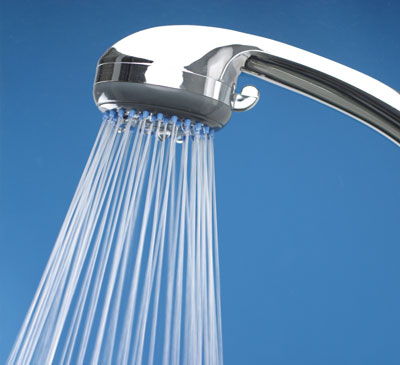Reducing water waste at home starts in the bathroom
February 2012

Dear EarthTalk: Is it true that the bathroom is where over half of our household water usage takes place? What are some ways to take a bite out of that?
– Shelby McIntyre, Chico, CA
Yes indeed, some 60 percent of our household indoor water usage happens in the bathroom. Updating old leaky fixtures and changing a few basic habits could go a long way in not only saving fresh water, an increasingly precious resource, but also money.
Undoubtedly, the toilet is the biggest water hog in the bathroom. Those made before 1993 use up to eight gallons of water per flush, five times what modern toilets use. “It’s a good idea to replace pre-1993 toilets if you can,” says Patty Kim of National Geographic’s Green Guide. (To find out how old your toilet is, the manufacture date is usually stamped under the lid.) If it is older and you can’t or don’t want to upgrade it, Kim recommends rescuing a two-liter soda bottle from the recycling bin and filling it partially with some water and sand or pebbles and then putting it into your toilet’s tank, where it will take up space and force your toilet to use less water every flush. Or get a Toilet Tank Bank for less than two bucks – it hangs in your toilet tank and displaces almost a gallon of water to save on every flush.
Plumbing leaks account for some 14 percent of the total water usage in an average U.S. home. Toilets are often a major culprit. Kim recommends testing your toilet by putting 5 to 10 drops of food coloring into the tank, then put the lid back on but don’t flush. Check back in 15 minutes or so to see if any of the colored water has leaked into the bowl. If so, you have a water-wasting leak, and it might finally be time to replace that aging toilet after all. The EarthEasy website reports that replacing an older 18-liter-per-flush toilet with an ultra-low volume, 6-liter-per-flush model “represents a 70 percent saving in water flushed and will cut indoor water use by about 30 percent.”
The shower can also be problematic as a water waster, especially if the showerhead in question was made before new regulations went into effect in 1992 that mandated lower flow – showerheads now can’t exceed more than 2.5 gallons per minute. You can check to see if your showerhead is older by turning the shower on full blast and catching its output for one minute in a 5-gallon bucket. If the bucket is full to overflowing, then your showerhead is an older, more wasteful model. Newer low-flow showerheads won’t come anywhere near to filling the bucket after one minute. A new showerhead costs around $10 and is a great investment because you can save water and money with every ensuing shower.
Regardless of whether or not you have a newer showerhead, you can save more water by turning off the shower to soap up, then turning it back on to rinse.
EarthEasy reminds us that even with a new showerhead, a moderately short shower can still use between 20 and 40 gallons of water. But that’s nothing compared to a bathtub, which can hold as much as 50 to 60 gallons of water.
Additional pearls of wisdom to reduce bathroom water waste include turning off the faucet while brushing your teeth. Better yet, fill up a glass with just enough water to rinse after brushing. Likewise for shaving – stop up the sink with a little warm water in it and wiggle your razor around in the basin between strokes. And if you suspect your faucet may be spraying harder than it needs to, unscrew the aerator tip where the water comes out and take it into a hardware store for a more stingy replacement.
Contacts: EarthEasy, www.eartheasy.com; The Green Guide, http://environment.nationalgeographic.com/environment/green-guide/


